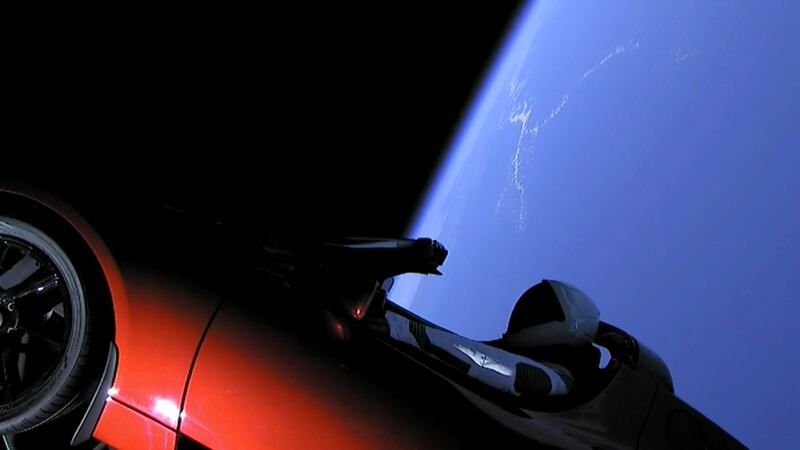Let's be clear about one thing: that SpaceX rocket launch on Tuesday was incredible.
Putting a Tesla Roadster into orbit atop it was a stroke of marketing genius; imagine the slogan "A bazillion miles without a charge!"
Let's also be clear about another thing: this has nothing to do with Tesla's performance as a company (even if the stock market sometimes implies otherwise.) On that front, 100,000 Model 3s idling on lots near Fremont, California, would be worth far more than one electric sportscar headed for the asteroid belt.
Alas, no such luck. A day after deserved jubilation in Cape Canaveral, it was back to the relatively mundane task of reporting Tesla's quarterly results. The big question was whether Tesla would shift its production target for the Model 3 back (again). It didn't, thankfully. However, as is often the case with this company, there are caveats:
It is important to note that while these are the levels we are focused on hitting and we have plans in place to achieve them, our prior experience on the Model 3 ramp has demonstrated the difficulty of accurately forecasting specific production rates at specific points in time.
In other words, Tesla's ambitions for the Model 3 remain intact, but please bear in mind that such ambitions have proved, on prior occasions, somewhat overambitious. There was no update on the current production rate, despite repeated questions on Wednesday evening's call, which is troubling.
Recall that, a month ago, Tesla claimed it had hit a pace that "extrapolates" to more than 1,000 vehicles per week. Whatever that meant exactly, it doesn't appear to have been sustained, at least according to sales estimates by InsideEVs: they put January Model 3 deliveries at a little less than 1,900 overall.
Getting the Model 3 production line fixed is critical if 2018 is to be, as Tesla puts it with typical restraint, "a transformative year." All that installed capital producing a trickle of vehicles trashes Tesla's gross profit margin. The 18.9 per cent headline margin for the automotive business was weak. Yet even that owed a lot to Tesla selling the largest slug of zero-emission vehicle credits for any quarter ever.
Tesla is struggling with what every Silicon Valley company taking its moonshot must ultimately do: scale. It expects to sell 100,000 Model S and X vehicles this year, meaning zero growth on that front. And even as Tesla boasts of growth on every other front, there's precious little to show for it in terms of operating leverage. For example, revenue jumped by 44 per cent in the fourth quarter, year over year. Yet the company's gross profit increased by less than 1 per cent, and its net loss more than tripled to its worst ever.
_______________
Read more:
Tesla to stick with Model 3 plan but says cash burn may rise this year
Sharjah company buys 50 Tesla electric trucks in first for region
_______________
What this ultimately comes back to is cash. On that front, Tesla actually came in much better than forecasts, with negative free cash flow just $277 million against a consensus figure of $901m. But again: caveats, folks.
First of all, definitions: Tesla doesn't count spending on solar energy systems to be leased as capital expenditure. This is understandable up to a point, but they eat up significantly more than $100m per quarter and should be counted somewhere (inventory?). Second, Tesla counts customer deposits as operating cash flow, even though these are refundable and, in essence, zero-interest short-term loans.
Still, let's assume the deposits are money in the bank. They jumped by $168m in the quarter, which is a good thing and reflects, at least in part, the addition of deposits for Tesla's new semi and updated Roadster.
Another big factor was negative working capital, contributing almost $500m. More than 40 per cent of that reflected running down inventories - as Tesla slowed production across the board in the quarter - and about another 20 per cent was due to a drop in accounts receivable.
Capex came in well below the consensus forecast, at $787m (not counting solar-energy equipment) rather than the $1 billion expected. Yet, as Tesla pointed out, that reflected some Model 3-related capex being deferred.
This is all somewhat reminiscent of the third quarter of 2016, when a big favourable swing in working capital, relatively low capex, and a jump in sales of emissions credits helped Tesla "throw a pie in the face of all naysayers on Wall Street", to use CEO Elon Musk's phrase. As then, most of these factors aren't repeatable.
And Tesla now expects capex in 2018 to exceed last year's level of $3.4bn, which happens to equal the amount of cash Tesla has in the bank. This, more than anything, is why Tesla must hit its stride on the Model 3. Otherwise, raising more capital could be unavoidable in the second half of the year.
On that front, Tesla has shown a talent for tapping different sources, such as last summer's high-yield bond issue. But this also comes at a cost:
the company's interest expense more than doubled, year over year, in the quarter and equates, remarkably, to a third of gross profit. Tesla had best reach escape velocity soon.
Bloomberg





